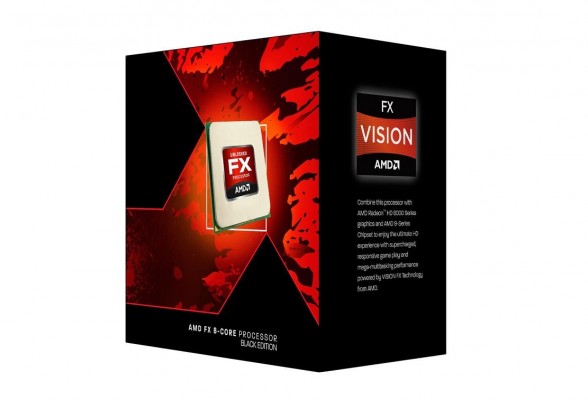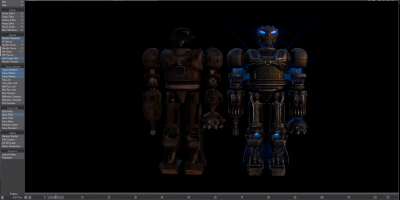AMD Announces the first 5Ghz 8-Core Processor.
 Can you imagine with one processor, having 40GHz of combined rendering power across 8 cores? Well, AMD has a processor in store for you.
Let me put that into perspective for you – what does this mean? Having 40GHz of processor power on your desk, or in a node on farm?Let’s do a flash back to the king of flash backs… Battle Star Galactica. I’m tired of bringing up that show, but it makes a great case study.
On Battle Star Galactica during Season II our machines for the render farm were dual single core (but “multi-threaded” so they would show up as 2 processors for each physical CPU) 3.2GHz Xeon processors. A single Xeon processor back then would cost about the same as a FX-8350 barebones based computer today. Those prices really haven’t changed much. Things are just “better” in terms of options and speed. You know, processor, mobo, 16GB of ram, hard drive, OS, Case, powersupply, minimal graphics card to get it to boot up as a render node. All standard stuff really for an off the shelf box or one you can put together at newegg.com or frys electronics.
Each one of those Xeon boxes cost almost 5000 bucks and that was before we were able to upgrade them from 4GB RAM to 8GB RAM mid-way through Season II, putting each box value at around $6500.00CND. A costly move but required for the work we were doing. Nothing special right? Hey it’s just money.
Well the new FX-9590, based on clock speed is 40Ghz of combined render power with 8 cores. The xeon based machines we had running would be 6.4 plus multi-threading boost to about 7GHz, maybe a little more. That’s a big frakkin’ difference. But consider the price. Or better yet consider how many of those machines we had to get 380GHz of combined render farm render power by the end of Season II. Ok here is some quick math. 380GHz / 7GHZ = 54.2 computers. That’s right. 54 machines, running 24/7 just to keep up with our production schedule. Keep in mind each box was 6500 bucks a piece. That’s 352,857 dollars in silicon, aluminium and copper. Fuck that shit.
Not exactly cost effective in comparison to building out and AMD solution using either dual Opterons or single processor dual core AMD FX64 processors at the time, which came out to far less. I built the second farm upgrade completely off of AMD processors for this reason alone (Even though certain people fought me on the decision believe it or not…), and added another 350 or so GHZ to the farm in using AMD as my processor choice, for the cost of roughly 30 of the Intel based machines before we upgraded their ram and OS. We simply got more bang for the buck. Period. Oh and unlike the Intel systems they didn’t blow up randomly, requiring full replacement or a brand new motherboard or new powersupply. Today things are even better. Oh the joy of fast and cheap! Better? Fast, cheap and solid performance!
Last fall AMD brought forward the FX-8350, a 4.0/4.2GHz 8 core processor which I happen to own, and love as I can easily overclock it to 4.8Ghz and run full bore with LightWave renders on it 24/7 without any issues. Yes, I have to water cool it (why wouldn’t you? It’s cheap and easy to do). Yes it sucks a bit of power, but it’s stupidly fast and enjoyable to use with products that demand more power when they need it. Earlier last week, AMD announced the next generation in the FX processor family with the FX-9590 running at 5.0GHz and the 4.7 GHz FX-9370. Both of which are running the Pile Driver Architecture which is an improvement over the slightly tripped up FX-8150 3.6GHz 8 Core that I also own (but I still really really like). No definitive word on pricing yet, but it looks like for a while at least that AMD will only be shipping these new processors to system integrator companies, but I expect that to change. What I don’t expect to change is that AMD will probably price this processor appropriately, by a lot less than Intel. It will also have the effect of driving the price of the current generation FX-85xx class processors down even further, which are already a fantastic buy. That means you can probably get a 5GHz FX-9590 processor as an option in a machine by August from a qualified vendor for around $275 dollars, maybe a little more. We will see. Total machine cost depending on options will probably be around 800 bucks. But that’s freaking amazing all things considered.
So how much money would you have to spend today to get the full render farm capacity of the in-house VFX department in Vancouver on BSG at the end of season III before they had me rip every thing apart and ship it (at even greater cost) to Los Angeles using the FX-9590 processors?? Let’s take a guess based on my numbers here. Never mind that I don’t build systems with anything less than 16GB of RAM in them today. We will just ignore that.
Let’s say on the high side that a new box based on the FX-9590 will run you a flat 1000 bucks. Cash. Ok 1000 bucks for a 40GHz system. no problem. Let’s take the number of 380Ghz and multiply that by 2 (our total farm capacity by the end of Season III which was effectively doubled from season II) for a total of 760Ghz. Divide that by 40GHz and you get the oh my gods… 19 computers. Yup. 19 computers. Better yet, 19 computers with 16 (maybe even 32GB of RAM) that cost about 1000 bucks and you to can pump out a frak load of VFX that will win you awards, providing you know what you are doing. That’s 19,000 dollars today compared to 352,857 dollars total spread across two seasons of purchase orders (and that’s just the boxes – also keep in mind the season III systems cost less because they were not intel – oh and never mind the 300 dollar APC UPS units we had to get for each of them to keep the Intel systems from browning out all the time, or the network cables/switches to network it all together at 800 bucks a pop of which we had 6 24 port units or something I can’t remember).
19 computers. About 19,000 bucks. Yes. It’s that awesome. How I wish I could have had that power for that price back then. Would have made a huge difference for us, and for me really because I had to run them all and keep them running. I might have even been able to relax a bit. Sigh. But that was then, this is now. I love living in the future.
Now I know there will be people out there who will say “you can’t just use clock speed as a measure of value/processing capability” blah blah blah. You know what I say to that? Screw you. Why? Because I can buy another system almost for the price tag of an Intel box if I do the components right. Then I have redundancy if something “does” happen and I’m not hosed to keep going (and the show must go on), that and I get more power! Why doesn’t this math work for certain people? Because they have not run render farms like I have, and they should be thankful – it’s a brutal job. Too bad more people don’t understand it like I do and a few others out there who really know what matters in a meat grinder production environment. Render or Die. It’s that simple on the surface, but it gets a lot more complicated really quick when you have everyone from bloated shot constructing VFX artists to ignorant management types to bitchy compositors and bumbling VFX PAs all wanting your attention and or the farm to themselves. Sometimes throwing smart money at the problem is the only way to solve it. I put my money on AMD because of this. They have never failed me. Do I sound jaded? Of course I do. But in the end I was right back then and I am again today. I trusted my Instinct.
You can read more about the new FX-9xxx class of processors here.
Suck on that Intel. http://www.amd.com/us/press-releases/Pages/amd-unleashes-2013jun11.aspx
Kat
Can you imagine with one processor, having 40GHz of combined rendering power across 8 cores? Well, AMD has a processor in store for you.
Let me put that into perspective for you – what does this mean? Having 40GHz of processor power on your desk, or in a node on farm?Let’s do a flash back to the king of flash backs… Battle Star Galactica. I’m tired of bringing up that show, but it makes a great case study.
On Battle Star Galactica during Season II our machines for the render farm were dual single core (but “multi-threaded” so they would show up as 2 processors for each physical CPU) 3.2GHz Xeon processors. A single Xeon processor back then would cost about the same as a FX-8350 barebones based computer today. Those prices really haven’t changed much. Things are just “better” in terms of options and speed. You know, processor, mobo, 16GB of ram, hard drive, OS, Case, powersupply, minimal graphics card to get it to boot up as a render node. All standard stuff really for an off the shelf box or one you can put together at newegg.com or frys electronics.
Each one of those Xeon boxes cost almost 5000 bucks and that was before we were able to upgrade them from 4GB RAM to 8GB RAM mid-way through Season II, putting each box value at around $6500.00CND. A costly move but required for the work we were doing. Nothing special right? Hey it’s just money.
Well the new FX-9590, based on clock speed is 40Ghz of combined render power with 8 cores. The xeon based machines we had running would be 6.4 plus multi-threading boost to about 7GHz, maybe a little more. That’s a big frakkin’ difference. But consider the price. Or better yet consider how many of those machines we had to get 380GHz of combined render farm render power by the end of Season II. Ok here is some quick math. 380GHz / 7GHZ = 54.2 computers. That’s right. 54 machines, running 24/7 just to keep up with our production schedule. Keep in mind each box was 6500 bucks a piece. That’s 352,857 dollars in silicon, aluminium and copper. Fuck that shit.
Not exactly cost effective in comparison to building out and AMD solution using either dual Opterons or single processor dual core AMD FX64 processors at the time, which came out to far less. I built the second farm upgrade completely off of AMD processors for this reason alone (Even though certain people fought me on the decision believe it or not…), and added another 350 or so GHZ to the farm in using AMD as my processor choice, for the cost of roughly 30 of the Intel based machines before we upgraded their ram and OS. We simply got more bang for the buck. Period. Oh and unlike the Intel systems they didn’t blow up randomly, requiring full replacement or a brand new motherboard or new powersupply. Today things are even better. Oh the joy of fast and cheap! Better? Fast, cheap and solid performance!
Last fall AMD brought forward the FX-8350, a 4.0/4.2GHz 8 core processor which I happen to own, and love as I can easily overclock it to 4.8Ghz and run full bore with LightWave renders on it 24/7 without any issues. Yes, I have to water cool it (why wouldn’t you? It’s cheap and easy to do). Yes it sucks a bit of power, but it’s stupidly fast and enjoyable to use with products that demand more power when they need it. Earlier last week, AMD announced the next generation in the FX processor family with the FX-9590 running at 5.0GHz and the 4.7 GHz FX-9370. Both of which are running the Pile Driver Architecture which is an improvement over the slightly tripped up FX-8150 3.6GHz 8 Core that I also own (but I still really really like). No definitive word on pricing yet, but it looks like for a while at least that AMD will only be shipping these new processors to system integrator companies, but I expect that to change. What I don’t expect to change is that AMD will probably price this processor appropriately, by a lot less than Intel. It will also have the effect of driving the price of the current generation FX-85xx class processors down even further, which are already a fantastic buy. That means you can probably get a 5GHz FX-9590 processor as an option in a machine by August from a qualified vendor for around $275 dollars, maybe a little more. We will see. Total machine cost depending on options will probably be around 800 bucks. But that’s freaking amazing all things considered.
So how much money would you have to spend today to get the full render farm capacity of the in-house VFX department in Vancouver on BSG at the end of season III before they had me rip every thing apart and ship it (at even greater cost) to Los Angeles using the FX-9590 processors?? Let’s take a guess based on my numbers here. Never mind that I don’t build systems with anything less than 16GB of RAM in them today. We will just ignore that.
Let’s say on the high side that a new box based on the FX-9590 will run you a flat 1000 bucks. Cash. Ok 1000 bucks for a 40GHz system. no problem. Let’s take the number of 380Ghz and multiply that by 2 (our total farm capacity by the end of Season III which was effectively doubled from season II) for a total of 760Ghz. Divide that by 40GHz and you get the oh my gods… 19 computers. Yup. 19 computers. Better yet, 19 computers with 16 (maybe even 32GB of RAM) that cost about 1000 bucks and you to can pump out a frak load of VFX that will win you awards, providing you know what you are doing. That’s 19,000 dollars today compared to 352,857 dollars total spread across two seasons of purchase orders (and that’s just the boxes – also keep in mind the season III systems cost less because they were not intel – oh and never mind the 300 dollar APC UPS units we had to get for each of them to keep the Intel systems from browning out all the time, or the network cables/switches to network it all together at 800 bucks a pop of which we had 6 24 port units or something I can’t remember).
19 computers. About 19,000 bucks. Yes. It’s that awesome. How I wish I could have had that power for that price back then. Would have made a huge difference for us, and for me really because I had to run them all and keep them running. I might have even been able to relax a bit. Sigh. But that was then, this is now. I love living in the future.
Now I know there will be people out there who will say “you can’t just use clock speed as a measure of value/processing capability” blah blah blah. You know what I say to that? Screw you. Why? Because I can buy another system almost for the price tag of an Intel box if I do the components right. Then I have redundancy if something “does” happen and I’m not hosed to keep going (and the show must go on), that and I get more power! Why doesn’t this math work for certain people? Because they have not run render farms like I have, and they should be thankful – it’s a brutal job. Too bad more people don’t understand it like I do and a few others out there who really know what matters in a meat grinder production environment. Render or Die. It’s that simple on the surface, but it gets a lot more complicated really quick when you have everyone from bloated shot constructing VFX artists to ignorant management types to bitchy compositors and bumbling VFX PAs all wanting your attention and or the farm to themselves. Sometimes throwing smart money at the problem is the only way to solve it. I put my money on AMD because of this. They have never failed me. Do I sound jaded? Of course I do. But in the end I was right back then and I am again today. I trusted my Instinct.
You can read more about the new FX-9xxx class of processors here.
Suck on that Intel. http://www.amd.com/us/press-releases/Pages/amd-unleashes-2013jun11.aspx
Kat « Loading EXRs with Alpha in Photoshop (Previous News)
(Next News) Rebel Hill Nodal Fundamentals is Now Free »
4 Comments to AMD Announces the first 5Ghz 8-Core Processor.
Leave a Reply
For Posting a Comment You must be Logged In.
















Kat,
So the AMD class of processors had no performance errors or non-compatiable snafus with any of your LW plugins. Does it sing well with all of your Adobe products: Premiere and After Effects.
I have always heard that Intel was the way to go but your article refutes that. You would recommend this for small farms as well.
Hey Jules.
Many many many years ago there were differences between Intel and AMD processor results. This can still happen with radiosity calculations in LW but that is not AMDs fault.
different processor architectures always seem to have the possibility of producing different stuff, but thus far, I have Phenom, PhenomII, and two different FX class types on my farm right now and they all get the same render results.
I don’t use adobe products really. But I have never heard of any issues or seen any issues when running AE for example which I open once in a blue moon. There is no “Must have” technological advantage of going with Intel over AMD. Unless of course you like spending money that you don’t need to.
I think energy saving can be an important factor here, more if u are using the render farm at home. AMD it´s cheaper at first compare to intel, but in long term, 24/7 home rendering can really hurt your wallet. And I´m not fan of any of both, just like to consider rendering power-efficiency-energy cost
Hey Rufus.
The power consumption difference is negligible really when you compare the savings in the machines by going AMD vs. Intel. Trust me on that one, I have been running the AMD boxes on home power for many years almost constantly and done the math. Consider this as well, CPUs may suck power when they are pushed, but hard drives suck power all the time. With the money one saves by going AMD its easier to consider SSD for the render nodes and still make it work on a budget. You get two advantages there. Fast start up times, less power consumption. That means more useful time spent rendering and that also adds to savings over all. If you do it right and render over dropbox (you can do this on a home network and the home network will sync the dropbox files for you to each machine) it makes the file accessible from the local systems of each node.That also has a major advantage of going really really fast as the files are synced across each system while you work and are pretty much available to every computer immediately. When you go to render the machines are now getting those files locally instead of having to pull them off a network and that also means fast speed and time savings which translates into power savings as well.